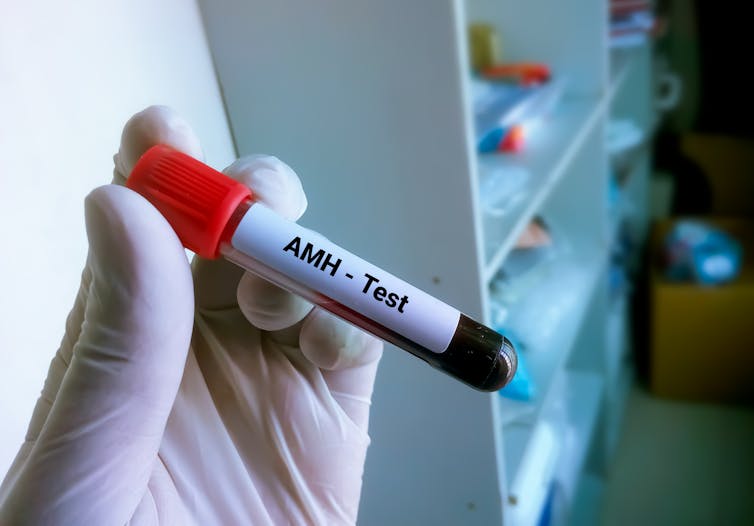A growing number of us are waiting longer to become parents. In the UK, the average age of first-time parents is between 30 and 33 years old. Fifty years ago, the average age was 26.
There are many reasons we’re choosing to have children later in life. On the one hand, waiting to have kids can allow us to create more stable lifestyles first, establishing a career and building our finances. But many of us also know that the longer we wait, the harder it can be to have children – with age being one of the biggest factors underlying infertility.
Given how big this decision is, it’s no wonder there’s growing interest in at-home fertility tests which are often advertised to people in their 20s and 30s. But while these test kits can provide you with some useful information, they can’t provide you with a full picture of your fertility.
This article is part of Quarter Life, a series about issues affecting those of us in our twenties and thirties. From the challenges of beginning a career and taking care of our mental health, to the excitement of starting a family, adopting a pet or just making friends as an adult. The articles in this series explore the questions and bring answers as we navigate this turbulent period of life.
You may be interested in:
Five things research can teach us about having better sex, according to a sex therapist
‘Love languages’ might help you understand your partner – but it’s not exactly science
Tailoring workouts to your menstrual cycle may help your physical fitness – but only if done properly
At-home tests
For women, peak fertility occurs between their late teens and late 20s. After the age of 35, a woman’s fertility declines more rapidly until, by the age of about 45, getting pregnant naturally becomes unlikely. While fertility also declines in men with age, they don’t experience such a dramatic drop from their mid-30s.
Read more:
Men’s fertility also declines with age — here’s what to know if you’re planning to wait to have kids
So the best age to conceive is often when having children may be far from a woman’s mind. This may explain the appeal of at-home fertility test kits, which promise to give you a picture of your fertility so you can better plan when you may want to start trying for kids.
A number of these tests are currently aimed at women. This is likely because unlike men, who produce sperm continually from puberty, women are born with all the eggs they will ever have.
Most kits work by having users provide a small blood sample, which is then sent off to a lab to be tested. To get a picture of fertility, these kits typically look at levels of specific hormones in the user’s blood – most commonly follicle-stimulating hormone (FSH), luteinizing hormone (LH), and anti-Mullerian hormone (AMH).
Tests which look at FSH and LH can give a general idea of a woman’s hormonal balance, and can indicate when ovulation may occur. This can help determine when it might be the best time to have sex if you’re trying to get pregnant.
AMH levels are used as a marker for the number of eggs remaining in the ovary. So tests which look at AMH levels might be able to indicate if your fertility is declining.

Saiful52/ Shutterstock
These tests can tell you about your fertility now, but they can’t predict your fertility in five or ten years’ time. Furthermore, while they can help monitor hormone levels or the number of eggs still in the ovary, they can’t tell a woman if she’s infertile.
This is because they don’t measure the quality of a woman’s eggs or detect if she has any physical complications (such as blocked fallopian tubes) preventing her from becoming pregnant. This kind of information can only be shown through other tests, such as an abdominal scan.
Researchers have also recently warned against putting too much emphasis on determining fertility status from just a few, select biological factors. This is because fertility is regulated by a complex array of biological and lifestyle factors such as weight, poor diet, smoking and excessive alcohol intake.
Fertility problems
While most of these at-home fertility tests are targeted at women, fertility is as much a consideration for men as it is for women.
Approximately one in eight couples are affected by infertility. This is defined as being unable to get pregnant after 12 months of regular, unprotected sex.
There are many reasons why infertility may happen, such as hormonal imbalances, problems ovulating, or ovulating eggs of poor quality. In women, prior infections can also be a factor. In men, infertility is often the result of a very low sperm count and can be a consequence of prior infection. But in many cases, the causes are unknown.
Many men may believe that if they can get an erection and ejaculate, there’s no problem with their fertility. Men may also believe that age is not as much of an issue for their fertility as it is for women.
However, infertility is increasing in men and is seen as a product of our modern lifestyle. Obesity, smoking, poor diet, excessive alcohol intake and recreational drug use have all been linked to lower fertility in men.
While men can also purchase home fertility testing kits online, these tests usually only tell you how many sperm you’re producing in each ejaculate. The shape (morphology) and speed (motility) of sperm are also crucial factors in determining a man’s fertility – but these aren’t usually measured by these kits. Undergoing a full clinical semen analysis is still the best way for a man to assess his fertility.
The picture of modern fertility is changing – with fertility rates declining around the world. In many countries, fewer children are being born today than 60 years ago. Recent studies also show that sperm counts have decreased by nearly 60%.
However, making some simple lifestyle changes each day may help improve your fertility. For instance, losing weight and avoiding smoking and drinking in excess can all improve a couple’s chance of getting pregnant.
So if you are thinking of having children – whether in the near future or much later – making changes to your lifestyle is a good place to start if you’re concerned about your fertility.




